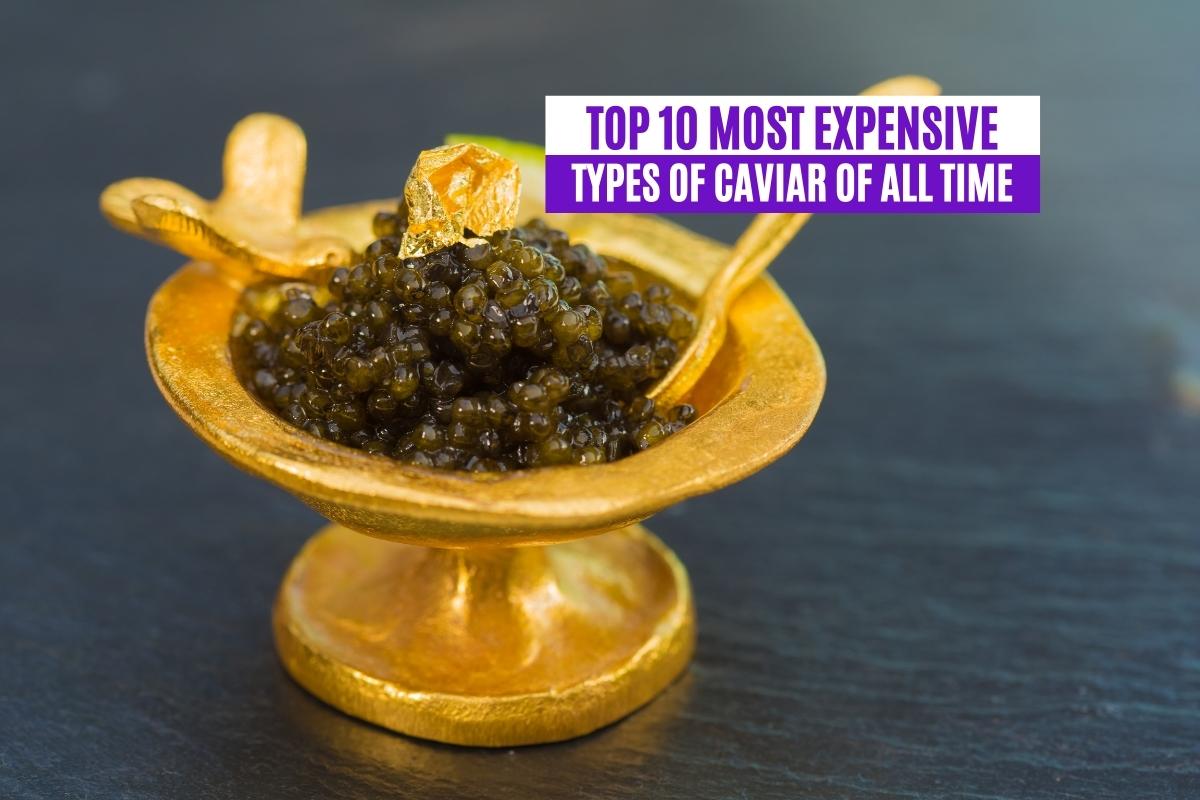Caviar has an international reputation for being a favorite snack of the wealthiest and most affluent diners. Caviar’s reputation as a luxurious treat dates back to Ancient Greece, but which modern types of caviar are the most extravagant and expensive?
The most expensive caviar of all time is Strottarga Bianco. This dehydrated white caviar costs about $113,630 per kilogram. Created by order by Austrian fish farmer Walter Grüll, the roe used to make this caviar is harvested from albino sturgeon and mixed with powdered 22-carat gold leaf.
This ranking will reveal the priciest caviar ever made, helping you choose a decadent (and expensive) snack to suit your refined palate!
Here Are the Top 10 Most Expensive Types of Caviar of All Time:
- Strottarga Bianco – $113,630 per kilogram
- Almas – $34,500 per kilogram
- Petrossian Special Reserve Kaluga Huso Hybrid – $16,000 per kilogram
- Petrossian Special Reserve Ossetra – $12,900 per kilogram
- Petrossian Ossetra President – $7,900 per kilogram
- Caviar House Finest Caviar Beluga – $7,894 per kilogram
- Prunier Héritage – $7,164 per kilogram
- Caviar Express Beluga Hybrid – $6,000 per kilogram
- World Port Seafood American Sturgeon Caviar – $5,291 per kilogram
- Volga Reserve Ossetra – $5,000 per kilogram
10. Volga Reserve Ossetra – $5,000 Per Kilogram
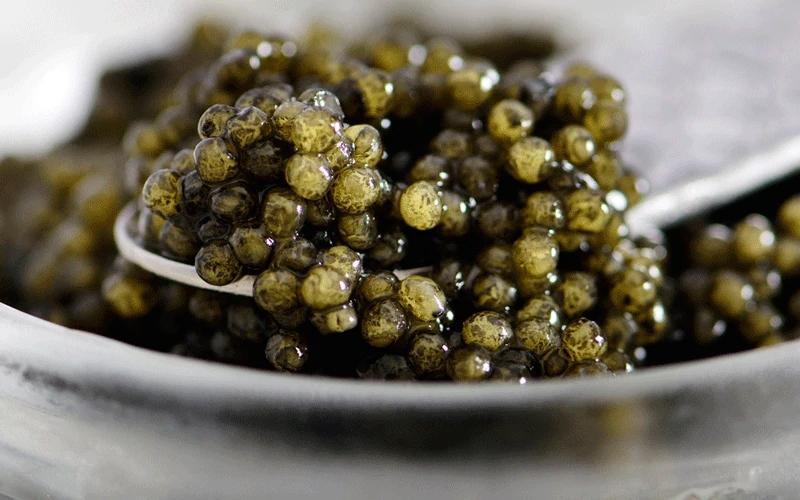
The seaweed-green pearls that comprise Volga Reserve Ossetra almost look like glistening emeralds. And because this caviar costs $5,000 per kilogram, they’re also as expensive as emerald gemstones!
This is one of the saltier options included in this ranking, as it’s prepared in traditional Russian style. The fish used to produce this gorgeously green roe also originates from the Volga River, one of the main tributaries feeding into the famed Caspian Sea.
However, the fish are raised on farms and allowed to reproduce in human-made environments, making this caviar one of the most sustainable options.
Why It’s Expensive
Due to the years-long ban on beluga caviar, this caviar has become an expensive commodity. Wealthy consumers who looked for substitutes to beluga caviar found that Volga Reserve Ossetra fit the bill.
Though bans have since been lifted, the waiting list for this caviar is still quite long. Many buyers must wait months to get their hands on a container. Demand (and quality) is the main reason this caviar is so pricey.
9. World Port Seafood American Sturgeon Caviar – $5,291 Per Kilogram
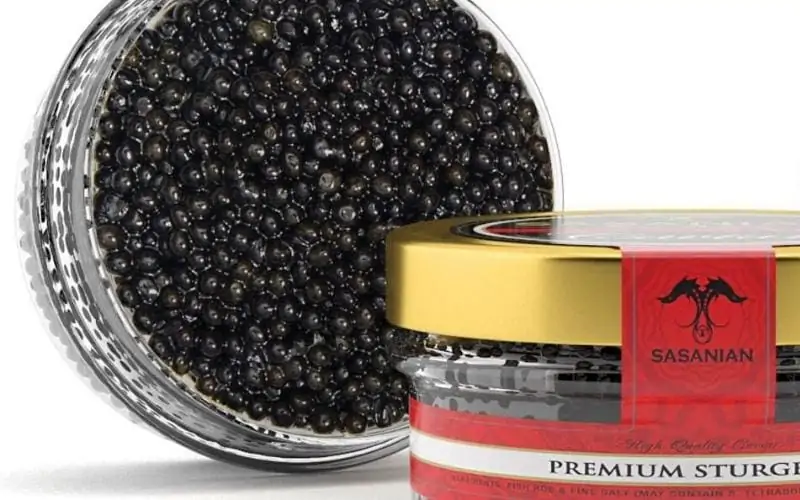
Omaha Steaks isn’t known for its caviar selection. However, this brand offers one of the most expensive types of caviar: World Port Seafood American Sturgeon Caviar.
This option is priced at $5,291 per kilogram and arrives in a glass container. This packaging ensures that the caviar never has an unpleasant metallic taste.
Even better, this roe is harvested from American sturgeon raised on fish farms. As such, it’s an eco-friendly alternative to other gourmet caviar.
Why It’s Expensive
These jet-black pearls are expensive due to their high quality and sustainable origins. More caviar connoisseurs are switching to sustainable options like this, driving up demand. But as demand increases, so does the price.
8. Caviar Express Beluga Hybrid – $6,000 Per Kilogram
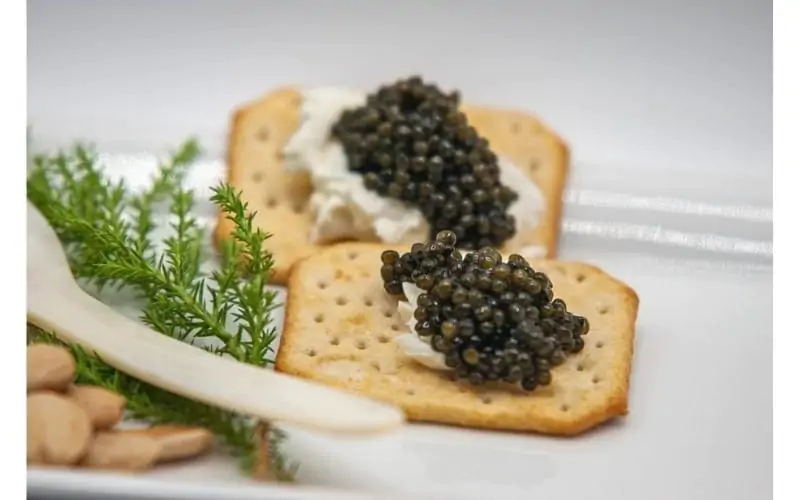
This unique type of caviar became incredibly popular in the United States during the country’s ban on beluga caviar. That’s because it’s very similar to beluga caviar, but it’s produced via hybrid fish, resulting in a more sustainable source.
If you’re eager to try rich and nutty caviar without contributing to problematic fishing practices in the Caspian Sea, you may find this caviar’s $6,000-per-kilogram price is well worth it.
Why It’s Expensive
The main reasons this caviar is so costly are demand and flavor. For years, caviar lovers in the United States couldn’t order beluga caviar. But the taste of beluga caviar is unmistakable and sought-after.
As such, the demand for hybrid beluga options skyrocketed. Though bans have lifted, many may still opt to enjoy hybrid varieties like this, resulting in higher prices.
7. Prunier Héritage – $7,164 Per Kilogram
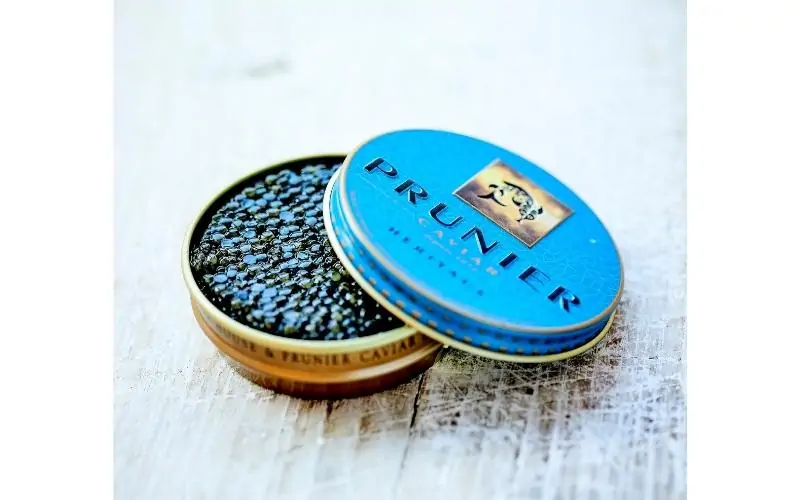
A bright blue tin of Prunier Héritage caviar could brighten your day and thrill your tastebuds, but only if you’re willing to spend a sizeable amount of dough. After all, a 30-gram container costs ₤180.00(about $219), equating to about $7,164 per kilogram.
Still, you’ll receive a vacuum-sealed tin of premium-quality caviar for that price. This roe is often described as light, with a subtle flavor that pairs well with a glass of white wine.
Why It’s Expensive
This caviar is vacuum-sealed to maintain its freshness, giving it a higher-than-average shelf life. This quality makes it a natural choice for refrigerated pantries. In short, this caviar’s packaging is one of the primary reasons it’s so costly.
Of course, its branding (Prunier is a reputable caviar supplier) and quality also contribute to its high price.
6. Caviar House Finest Caviar Beluga – $7,894 Per Kilogram
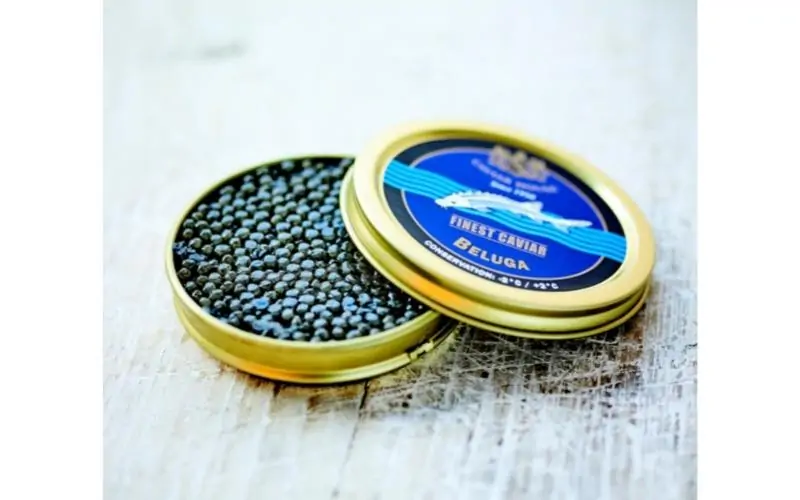
Caviar House & Prunier is the premier gourmet caviar supplier in the United Kingdom, and their costliest caviar is the Caviar House Finest Caviar Beluga. This decadent treat costs $7,894 per kilogram and consists of dark gray beluga sturgeon pearls with a distinctly salty flavor.
As such, a tin of this caviar would taste exquisite paired with sweet or savory ingredients, including a buttery cheese or sweet slice of apple.
Why It’s Expensive
The most sought-after caviar on the planet is often beluga sturgeon caviar. That’s because this type of caviar is comparatively rare, especially when considering the availability of bright red salmon caviar (often paired with sushi).
This scarcity makes high-quality beluga caviar a desirable commodity, especially among the world’s wealthiest caviar connoisseurs. This high demand (and low supply) often results in high prices, which is undoubtedly true of this option.
5. Petrossian Ossetra President – $7,900 Per Kilogram
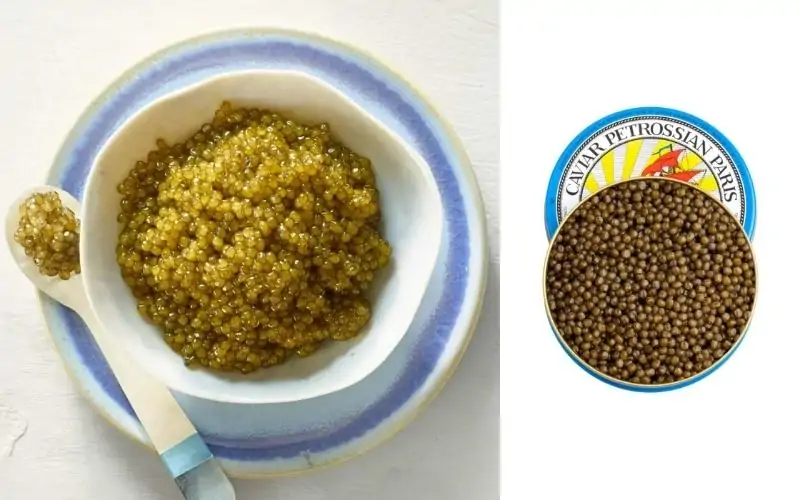
While Russian and Iranian caviar often tops the lists in terms of price, it’s crucial to remember that French cuisine also incorporates high-quality caviar. As such, it should be no surprise that Petrossian (one of the most established French caviar brands) caviar earns several spots on this ranking.
One of their more affordable (but gourmet) options is Ossetra President caviar, a green-brown roe harvested from Ossetra sturgeon. Rather than having a fishy flavor (common among low-quality caviar varieties), this caviar has a pleasant fruity flavor enriched by its firm texture.
Ready to try some for yourself? If so, you’ll need to spend $7,900 per kilogram or $249 per 30-gram single-serving container.
Why It’s Expensive
All Petrossian caviar will cost you more than the average brand available from your local supermarket. That’s because Petrossian is one of the most reputable and luxurious French caviar brands. As such, there’s high demand for this brand’s products.
Not only does this company focus on aging its caviar to peak flavor, but it’s also dedicated to only using the most sustainable roe. Unfortunately, with this reputability comes higher costs, as more labor is required to ensure consumers enjoy only the best (and most eco-friendly) caviar.
Diners outside France can also expect to spend more on Petrossian caviar due to transportation fees! After all, caviar kept in the wrong conditions can quickly go bad.
Fortunately, Petrossian offers overnight shipping to ensure customers receive the freshest possible products. But this fast shipping does contribute to costs.
4. Petrossian Special Reserve Ossetra – $12,900 Per Kilogram
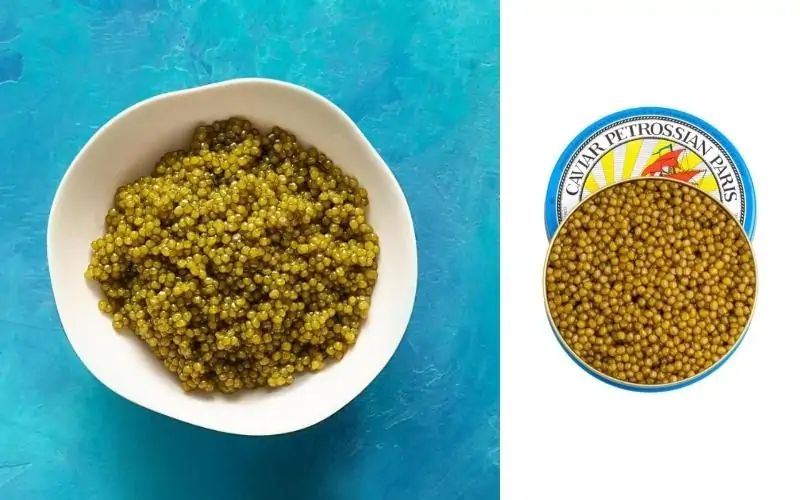
This type of caviar exudes several qualities associated with top-notch caviar. Firstly, it has an almost golden hue, with touches of green-yellow throughout. This is one of the most desired colors, as it’s far rarer than brown or red caviar.
Secondly, it’s an Ossetra caviar. It trades saltiness for a more buttery, almost nut-like flavor. This distinct flavor profile pairs well with charcuteries, particularly those containing fresh fruits.
You can expect to spend $12,900 per kilogram of this exquisite caviar. But, for the most lavish dining experience, you may want to pair this caviar with a cup of one of the world’s most expensive teas!
Why It’s Expensive
These yellow-green pearls of caviar are harvested from sustainable fish farms, but they have the taste and quality associated with the most delicate wild-caught fish roe. That’s because every ounce of Special Reserve Ossetra is specially selected from Europe’s most reputable fish farms and caviar suppliers.
Due to this option’s superior quality and distinct flavor, it’s a favorite among caviar lovers worldwide. But, as you might expect, this high demand translates to high prices. Still, Special Reserve Ossetra isn’t the most expensive option available from the Petrossian brand.
3. Petrossian Special Reserve Kaluga Huso Hybrid – $16,000 Per Kilogram
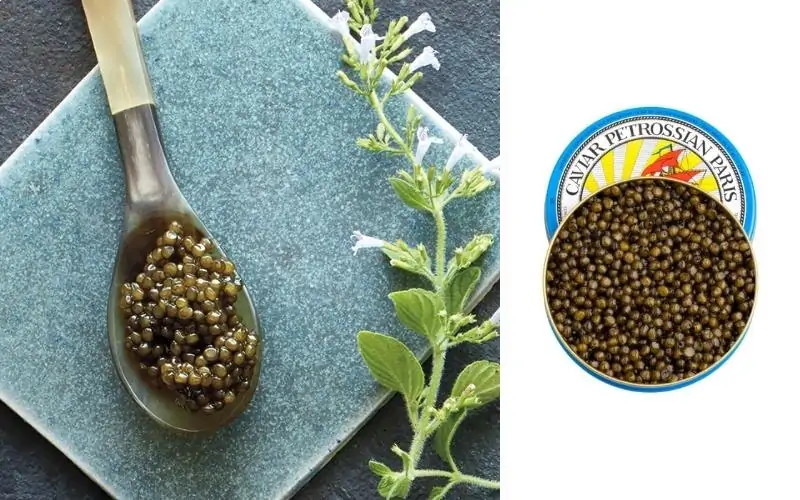
The most expensive caviar available from Petrossian is the Special Reserve Kaluga Huso Hybrid. This caviar is purported to have the taste of beluga caviar (once banned in the United States), making it a fantastic alternative to pricier options.
However, this firm, greenish-brown caviar costs $16,000 per kilogram, so you’ll need to be willing to pay big bucks to enjoy a taste.
Why It’s Expensive
The Kaluga fish is a type of beluga that lives in rivers. Its roe tastes similar to beluga sturgeon roe, making it an in-demand alternative to hard-to-find Caspian Sea caviar.
This high demand (and perceived quality) influences the price of Kaluga caviar, making it one of the priciest options in the world.
2. Almas – $34,500 Per Kilogram

Almas is a type of black caviar that often fetches as much as $34,500 per kilogram. This high price makes it more expensive than the world’s most expensive cheeses!
This sturgeon caviar is a gorgeous gold color, and its flavor is often described as buttery. The texture is uniquely creamy, differentiating it from firmer varieties.
It’s also worth noting that the rich yellow coloration of Almas caviar is relatively rare, making it naturally more valuable the black caviar.
These fish are harvested from the Caspian Sea, an inland sea bordered by Russia, Iran, and Kazakhstan. According to Guinness World Records, this rare caviar is harvested from albino sturgeon fish in this large body of salt water, some of which are 100 years old.
Notably, fish harvested from the Caspian Sea (and their eggs) are considered far cleaner and safer than those harvested from larger bodies of water like the Atlantic or the Pacific Ocean. That’s because this sea isn’t directly connected to other seas or oceans, reducing its exposure to global sources of water pollution.
Why It’s Expensive
There are several reasons why Almas is one of the priciest types of caviar. Firstly, it’s harvested from aged albino sturgeon from the Caspian Sea. As such, the source of this caviar is exceptionally limited.
Secondly, this caviar’s flavor and color are extremely attractive to caviar connoisseurs, ensuring that the demand for Almas always outweighs the supply. As the law of supply and demand dictates, this results in a higher-than-average price.
1. Strottarga Bianco – $113,630 Per Kilogram
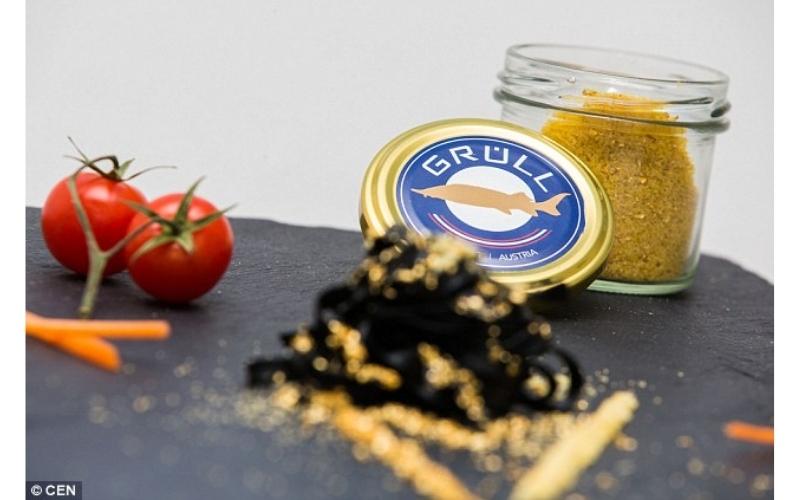
The most expensive caviar of all time is Strottarga Bianco. When this caviar was initially released in 2015, it cost €100,000 per kilogram (or about $113,630 per kilogram).
In addition to being one of the few types of caviar harvested from albino sturgeon (which rarely occur in nature), this caviar is imbued with a 22-carat gold leaf. This addition gives it a slightly metallic appearance and makes it significantly more valuable.
Notably, the texture of this caviar is very different from most. While most caviar is kept moist in sealed cans, this type is dehydrated and ground into a fine powder.
If you’d like to purchase a container for yourself, you may be somewhat dismayed to learn that you can’t simply order it online. Instead, you’ll need to request a can directly from its maker, an Austrian fish farmer named Walter Grüll.
Why It’s Expensive
This caviar’s high price results from several factors. Firstly, it contains high-priced gold leaf, an ingredient that can inflate the price of any food or beverage. After all, gold is one of the highest-value precious metals on the planet!
Secondly, this caviar is made from pure white roe harvested from ultra-rare Siberian albino sturgeon. Fish roe is typically beige, brown, black, or red. White eggs are scarce, which adds to the value of this caviar.
Finally, there are production techniques to consider. Most caviar is priced by weight, but it’s crucial to remember that most of the weight comes from water. That’s not so with this caviar.
That’s because Strottarga Bianco is made from dehydrated roe that is ground into a fine powder. As such, it contains more roe than similarly-sized containers of caviar.
These qualities combine to make Strottarga Bianco the priciest (and most luxurious) caviar ever.
Why Are Some Types of Caviar So Expensive?
Now that we’ve discussed the most expensive caviar of all time let’s take a moment to address one of the most common questions people have about caviar: Why is it so expensive?
Generally, this salty snack costs more than other foods because of:
- Labor costs
- Fish rarity
- Demand
Let’s quickly review these factors to understand how they impact caviar prices.
Labor Costs
The labor required to obtain caviar is one of the primary reasons it’s so expensive. Notably, labor costs are also one of the reasons lobster is so costly!
Caviar is essentially unfertilized fish eggs, so it can only be harvested from mature fish. As such, those with fish farms may need to wait more than a decade before they can harvest caviar from their fish stock.
Additionally, most caviar is harvested by cutting open a fish, as waiting for fish to lay eggs increases the risk of fertilization. This means that anglers must catch mature fish at just the right time, which can be tactically challenging.
Fish Rarity
Caviar harvested from the rarest wild fish (including the beluga sturgeon) tends to fetch higher prices than caviar harvested from common fish grown on fish farms. For example, the most expensive caviar of all time comes from wild-caught albino sturgeon that spend their lives swimming in the Caspian Sea.
Though this inland sea is quite large (143,244 mi²), the amount of wild fish living in it is limited. Overfishing in the Caspian Sea has become a problem over the last few decades, resulting in fishing bans.
These restrictions have significantly impacted anglers who fish for sturgeon, one of the most prized fish in the Caspian Sea. Consequently, the supply of Caspian Sea sturgeon caviar has fallen drastically, resulting in higher prices.
And while the supply of this type of caviar has decreased, demand has only increased, especially among the world’s wealthiest buyers.
Demand
The final factor influencing caviar prices is demand. While the average consumer might not shop for caviar regularly, the world’s most elite clamor for it.
As such, caviar’s demand is unique in that the world’s wealthiest consumers tend to be the primary market. This quality ensures that caviar prices remain high, attracting only the most financially prosperous diners.
What Is the Most Expensive Caviar?
The most expensive caviar ever produced is Strottarga Bianco, a type of white caviar covered in 22-carat gold leaf. This luxurious snack is priced at $113,630 per kilogram, equating to about $1,400 per tablespoon!
Like the second-most expensive caviar (Almas), this extravagant product is harvested from albino sturgeon. But unlike Almas, Strottarga Bianco is a bright white hue and is ground into a fine powder before being mixed with gold leaf.
If you’d like to learn more about the world’s most expensive foods, check out these articles now!

